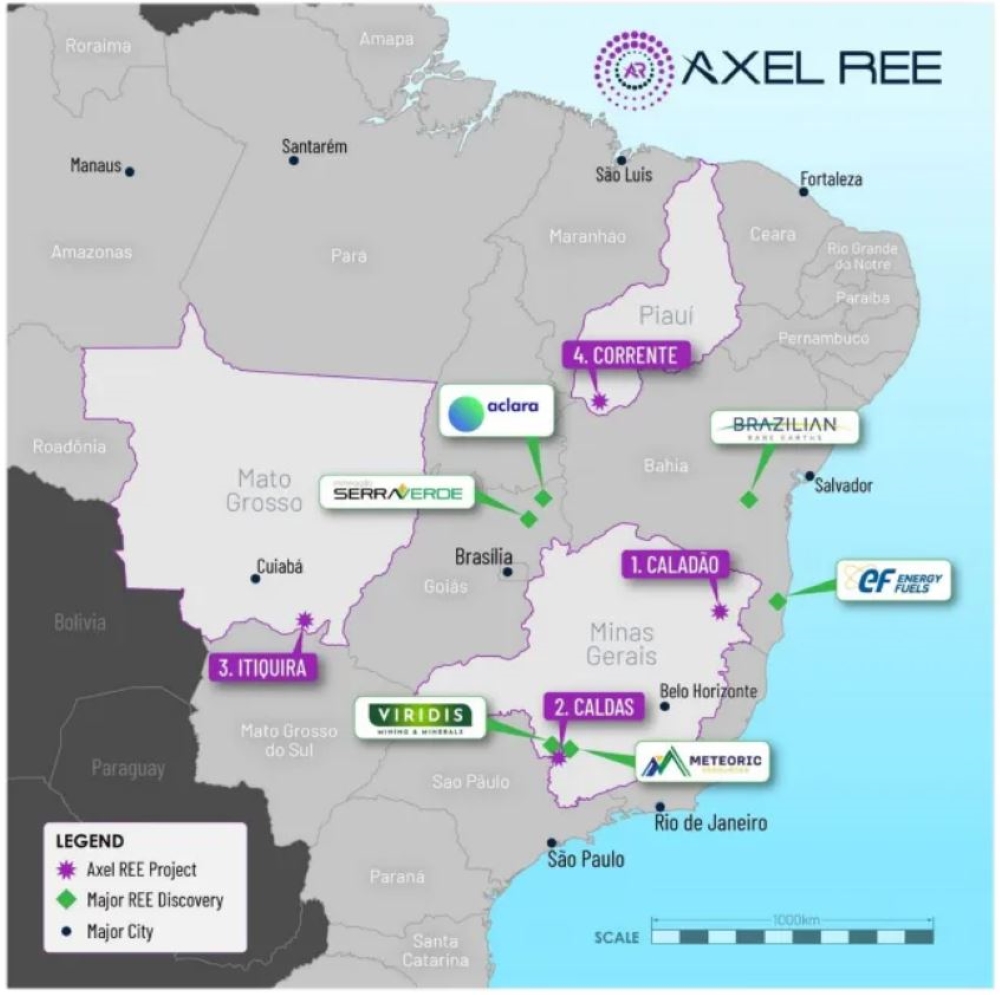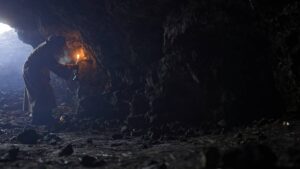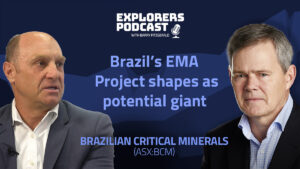Why ASX investors are backing juniors in Brazil’s rare earths scene

Pic: Getty Images
- Brazil’s rare earths sector is growing fast and ASX resources juniors keep winning
- Viridis CEO Rafael Moreno tells us why, and about its Colossus REE project
- Ionic clay-hosted deposits are some of the highest grade and easiest to mine in the world
Some of the best-performing resources small caps from the last financial year are still on the rise, as ASX juniors pour into Brazil’s rare earths sector and they have two things in common – location and commodity.
Where? Brazil. Dotted around the South American nation are ionic, clay-hosted (IAC) mineralised deposits with high concentrates of REEs, and, you betcha – a bunch of ASX-listed resources companies have jumped all over them in the past couple of years.
Why? It turns out that millions of years of certain volcanic activities in the region and a tropical climate have primed the region to crop up huge, easy to mine and high-grade IAC REE deposits – the likes of which, outside China and Myanmar, the world has never seen.
If you want the lowdown on why IAC deposits are all the hype, READ MORE: Why are ASX stocks so in love with clay rare earths projects? A punter’s guide
Winners in the Amazon grow
The juniors were some of the best performing ressie stocks last year with small caps among the stocks trying to break China’s hegemony over critical minerals production and processing.
Here was our list of the top performing ASX resources stocks for FY24: FY24 Resources Winners: REEs, niobium and gold explorers vie for the podium
One thing you’d notice very quickly is how many Brazilian rare earths stocks were on the winner’s table.
Gina Rinehart-backed Brazilian Rare Earths (ASX:BRE), with its 510Mt Rocha da Rocha REE project, would have made the grade had it not IPO’d in December 2023. It still made a handy 93% gain for those playing at home.
It listed at $1.60 and is trading at $2.89 at the time of writing. Not bad at all.
With adjacent tenements to BRE, Equinox Resources (ASX:EQN) did make the list, coming in at #14 after seeing a 71% rise in stock price while making its own impressive rare earth discovery at its Campo Grande project.
It’s working up to a maiden resource estimate, with recent drilling intercepting up to 6048ppm TREO (containing 22% high-value magnetic rare earths) at the Rio Negro prospect.
Incoming explorer into Brazil is Axel REE (ASX:AXL), which debuted at a loss on Tuesday in a $13.3m IPO and holds four projects across the country.
The junior says its focus will be on developing Caladão in Minas Gerais and advancing the Caldas project, which has shown enormous REE grades with intercepts of up to 7612ppm TREO, adjacent to Meteoric Resources’ (ASX:MEI) world-class Caldeira and close to Equinox and BRE’s tenure.
Meteoric didn’t make the list, having made most of its gains last calendar year and moving into the tricky post-discovery, pre-development stage for an explorer.
Australian Mines (ASX:AUZ) is right in the mix too, and has added REEs to the roster of its Resende lithium project after finding anomalies of the commodity of up to 2893ppm TREO.
It’s just 17km east of AMG Lithium’s Mibra spodumene mine – one of the longest-running in the world, in operation since 1945.
Also recently moving into the Brazil rare earths space is Perpetual Resources (ASX:PEC), which began its first drill campaign in June at the recently acquired Raptor project.
That site covers 380 hectares near Meteoric’s Caldeira in the largest alkaline complex in Brazil. Assays from an initial sampling exercise were due this month, with auger drill results expected to flow through from August.
It’s one of five projects in the Minas Gerais region PEC has picked up, with a number of pegmatite projects in the Lithium Valley also in PEC’s portfolio.
Brazilian Critical Minerals (ASX:BCM) owns the larger but lower grade Ema project, where it is aiming to upgrade an inferred resource of 1.02Bt at 793ppm TREO focusing on a high grade portion, and Resouro Strategic Metals (ASX:RAU) recently delivered a high-grade maiden REE and titanium resource of its Tiros project of 1.7Bt at 3900ppm TREO.

A Colossus IAC deposit and 101 with Rafael Moreno
But, with a 459% increase, Viridis Mining and Minerals (ASX:VMM) came in at #2 on our FY24 resources small cap winners list, as the market watched the junior prove up its now colossal 201Mt at 2590ppm TREO Colossus IAC REE project.
Stockhead spoke to VMM CEO Rafael Moreno, a process engineer by trade, who laid out why Brazil is the perfect place to grow REE production, including market interest, why Brazil’s geology is so fruitful and what to look out for when proving up a rare earths deposit.
“It’s shaping up that Brazil is going to play a really important role in the supply of REEs in the future and being a pro-mining jurisdiction, the future is looking good,” Moreno says.
He says knowing your development pathway is crucial when it comes to rare earths.
“There’s always a bit of luck when proving up a deposit but with rare earths it’s never just that. As we’ve found, and done, you really can’t underestimate the importance of metallurgical testing,” Moreno explains.
“We probably weren’t expecting to find such a great resource so soon (with respect to the high-grade main Alkaline Complex at Colossus), that has shown extremely high REE grades.
“But proving the economics and process flowsheets is extremely important.”
Recovery methods and the importance of ionic
“We’ve seen a lot of actors in the space having to use expensive pH levels and high temperatures in the extraction process, which just adds to higher opex and, in turn, the cost of the project,” says the rare earths boss.
Earlier this month, VMM announced that testwork from samples at Colossus via ANSTO using run-of-the-mill (i.e. low-cost fertiliser) ammonia sulphate at a standard pH4, at room temperatures and with a 30 minute leach cycle could bust out strong recoveries of REEs, including 76% for NdPr and 65% for the high-value heavies dysprosium and terbium.
“Lowering capex of reagents is one thing, but if you you don’t confirm the metallurgy as economic you’d still come out at a pretty high point of the cost curve,” Moreno says.
“The simplicity of our flowsheet to extract from the ionics at Colossus puts us ahead of the game and in our neck of the woods (in Brazil) Mother Nature has done a job for us, as the ionic bond with the clay (host) sediment can separate the rare earths with basically neutral ~4.5 pH levels.
“Our bastnasite granite at Colossus has lower complexities and almost undetectable levels of (the) thorium and uranium that are generally found attached to REE mineralisation. This is important as radioactive elements make the separation methods cost a lot more.”
The explorer is almost ready to release a scoping study, which Moreno reckons could show Colossus’ production metrics come in at lower cost levels than that of interpreted Chinese projects.
“Then there’s a PFS and DFS to complete. Once we’ve got those ducks in a row, ideally we’ll be aiming for a non-dilutive pathway to financing the project into production to maximise returns for our shareholders,” he said.
At Stockhead we tell it like it is. While Equinox Resources, Australian Mines, Meteoric Resources and Viridis Mining & Minerals are Stockhead advertisers, they did not sponsor this article.
This article does not constitute financial product advice. You should consider obtaining independent advice before making any financial decisions.
Related Topics

UNLOCK INSIGHTS
Discover the untold stories of emerging ASX stocks.
Daily news and expert analysis, it's free to subscribe.
By proceeding, you confirm you understand that we handle personal information in accordance with our Privacy Policy.








